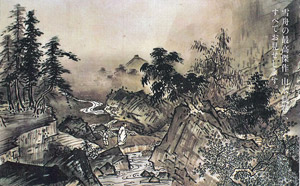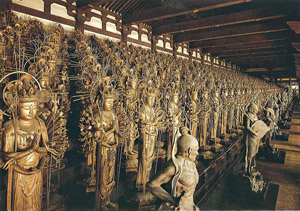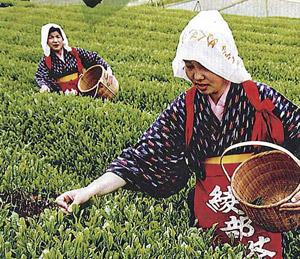The Allure Of Antiquities In Japan
This is the second in a two-part series on my recent visit to Japan, the second in 15 months.
I like old stuff, which is one of the reasons I enjoy visiting Japan, a land that from the beginning of time seems to have been high-tech, whatever the newest tech happened to be.
My affection for antiquities may or may not have anything to do with being from a country that is just 236 years old, living in a state that is just 53 years old, and working in a town where a business can advertise proudly about its longevity, as MidWeek can, “In business since 1984!”
My recent trip to Japan provided opportunity after opportunity to see some really cool old stuff up close. There’s no finer example of that than an exhibition at the Suntory Museum in Midtown Tokyo, “Treasures of the Mohri Family.” The Mohri clan ruled in Japan for 71 generations during the feudal period, and the men were known as warrior-poets. (They don’t make a lot of those anymore, do they?) The exhibition included warrior armor, a samurai sword that looks as if it were forged last week, beautiful pottery cups and bowls, and intricately sewn kimono.
But two artifacts stand out. The first is an ink-and-brush painting known as Sansui Chokan (Landscape of the Four Seasons, or Long Scroll of Landscapes) by the legendary artist Sesshu.
More than 600 years old, the scroll is a designated National Treasure. I paced it off, and it’s 54 feet long. After studying it for about 15 minutes, and moving on to other pieces of the exhibition, I kept coming back to Sesshu’s scroll, marveling.
Likewise, I was taken by scrolls of perfectly preserved poetry written by an early Mohri. Amazingly, he wrote in black ink – and edited his work in red ink! Seeing that, I couldn’t help slapping my leg and laughing out loud. Editing in red ink is the same thing that happens on deadline days at MidWeek when we proof pages. Some things never change, because they just make sense.
In Kyoto – a two-and-a-half-hour bullet train ride south from Tokyo Station, past rice paddies and rows of neatly trimmed green tea bushes, the sea off to the left and dramatic mountains to the right, Mount Fuji peeking from behind clouds – I found lots that was marvel-some.
It began with the “Thousand And One Buddhas” at Sanjusangendo, founded in 1,164 A.D. A wooden structure, longer by 90 feet than a football field, houses 1,000 nearly identical golden Buddhas, hand-carved, with one much larger Buddha, and all of them guarded by intricate statues of 28 protective deities. (As the Dalai Lama must be protected today from Communist Chinese agents.) The architecture required to design and construct a building this large is remarkable in itself.
Up the hill (and up and up at least 300 meters), Kiyumizo-dera Temple was established in 798 A.D. The current structure dates merely to 1,633. Another National Treasure, it is built into a mountainside on 139 massive wooden pillars that support a deck overlooking Kyoto. Another amazing example of architecture, for it has withstood time and countless earthquakes.
A 10-minute walk from Yasaka Shrine (home of the Obama Made In Japan chop-stick vendor, mentioned last time) is more remarkable architecture, and a hidden temple – inside the high entrance gate. To reach it you climb wooden steps so steep and tall, the hand-railings are actually ropes, so you can pull yourself up the big steps. At the top is a jaw-dropping sight, a candlelit room with 16 big golden Buddhas, and incredible ceiling paintings with Buddhist themes by the artist Kano, whose family is to Japanese temple/palace art what the Bachs are to European music.
The historic Imperial Palace, which dates to 784 A.D., is massively wonderful, and I’d advise paying a few yen for a guided tour – lots of good information. The palace made me think of the Mel Brooks line from History of the World Part I, with a slight paraphrase: It’s good to be emperor!
Nearby is massive Nijo Castle, built in 1603 by the original Tokugawa Shogun, Ieyasu. Constructed of huge, fitted, hand-cut stones, it makes you think of the pyramids in Egypt. The walls are surrounded by a moat, and inside is a sprawling palace complex, fantastic gardens and another moat and more stone walls. As a projection of power, it is impressive.
Across the street, I happened to discover Heihachi restaurant, just 60 years old but located on the edge of a lake in Shinsen Park, which Emperor Kama built in 794. From across the lake, created by a fresh spring called “God Spring,” wafted the sound of monks playing rhythmic-meditation drums, gong and flute. The green tea cold soba noodles were fantastic with a cold draft Asahi beer on a warm spring day as cherry blossoms drifted gently into the lake.
Speaking of food, two other Kyoto recommendations:
Issinkyo, at the ryokan (traditional inn) Yuzuka, adjacent to Yasaka Shrine. The food is as delicious as it is artistic, even at breakfast. The boiled, then grilled bamboo root is as tasty a vegetarian dish as I’ve ever enjoyed.
A short walk away is a wonderful tempura house, Tempura Endo Yasaka, where chef Tatsushi Hisatake is in nonstop motion preparing perfect morsels, washed down with locally brewed sake. His dream, he mentioned, is to own a tempura restaurant in Hawaii.
As a tea buff/snob, I was pleased to discover a Gion tea shop at the Kyoto train station, and brought home some of the finest green and hojicha teas I’ve tasted, grown in nearby fields. I sip slowly and inhale the aroma, and am transported pleasantly back to a land I’ve come to love.






